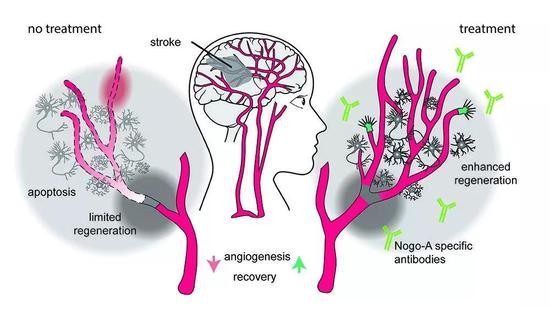Promote cerebral vascular repair, new treatments are expected to challenge the "number one cause of death" June 27, 2019 Source: Academic Jingwei According to the latest research report published by the top medical journal Lancet, stroke (commonly known as stroke) is the biggest disease burden and main cause of death in China in the past 30 years. Stroke is also one of the leading causes of death worldwide. Because a stroke causes brain damage, two-thirds of stroke patients who die or leave a disability require lifelong care. However, therapies that currently reduce the serious consequences of stroke are still very limited. A new study published this week in the Proceedings of the National Academy of Sciences brings hope to new treatments for ischemic stroke. Researchers from the University of Zurich in Switzerland use an antibody to promote angiogenesis in affected brain regions. Mouse models have shown that this antibody therapy can help animals recover from motor function after stroke. Vascular and neuronal regeneration is very difficult after an ischemic stroke. Some scientists have used the repair of blood vessels as a therapeutic target, hoping to restore the vascular system in the affected brain area, provide oxygen and key nutrients to the injured tissue, and promote the recovery of the nervous system. But this repair process is very complicated and is affected by many factors. For example, in the past experiments to promote blood vessel growth mainly focused on the supplementation of angiogenic factors, but it was later found to have a bleeding risk and was not clinically feasible. Professor Martin Schwab led his research team to find another way. A work he and his colleagues published in Nature found and identified an important signaling molecule, Nogo-A, that inhibits neurite outgrowth in the central nervous system. Blocking this inhibition signal helps stimulate the growth of damaged nerves, which also brings hope for the treatment of spinal nerve injury. Interestingly, Professor Schwab further discovered that Nogo-A may also inhibit angiogenesis in the central nervous system. In a mouse model of ischemic stroke, the researchers found that Nogo-A and its receptor SIPR2 are expressed in cells surrounding the infarcted necrotic brain. Then, to prevent the possible inhibition of Nogo-A, can it help stroke patients to restore blood vessel growth and promote the repair of blood vessels and nerves? The researchers first used gene knockout to examine the effect of down-regulating the Nogo-A pathway on angiogenesis in a mouse model of ischemic stroke. Compared with the vascular structure of normal mice, the mice lacking Nogo-A or the receptor SIPR2 showed significant improvement in blood vessel growth and showed better regeneration ability. Subsequently, the team tried to block the Nogo-A protein with an anti-Nogo-A antibody. As mentioned earlier, Professor Schwab initially discovered the signaling molecule Nogo-A during the study of spinal nerve regeneration, and they have developed anti-Nogo-A antibodies for the treatment of spinal cord injury in a phase 1 clinical trial. Proven security and feasibility. This time, the researchers injected anti-Nogo-A antibodies into mice after stroke. The application of the antibody for 2 weeks showed an effect of promoting blood vessel growth, and after 3 weeks, it was found that the blood vessel area was increased by 102%, and the number of blood vessel bifurcations was increased by 436%. The results of blood flow measurements also indicate that the newly growing blood vessels in the mouse brain already have a delivery function. Hemiplegia and numbness are common sequelae of stroke, so it is very important to recover from motor function. In animal models, stroke mice exhibit dyskinesia such as limb asymmetry. Behavioral experiments showed that after blocking Nogo-A with antibodies, or knocking out Nogo-A or its receptor, the limb motor function of stroke mice was also significantly improved after 3 weeks. Along with the repair of blood vessels, the researchers also found that the nervous system of the mice treated with antibody also showed promising changes, including the enhancement of the survival of some interneurons, and the increase of neurotransmitter dopamine levels related to motor function. Apoptosis is reduced in the affected brain region, and nerve fibers in the ischemic marginal zone are enhanced. These positive results have greatly inspired the researchers. The first author, Dr. Ruslan Rust, said: "Especially considering the anti-Nogo-A antibody has been used in clinical trials for the treatment of spinal cord injury, our findings provide a treatment for stroke patients. A promising new approach." While expecting scientists to bring new treatments, it is important to share with readers that many studies have also pointed out controllable risk factors for stroke, such as smoking, unhealthy diet, and lack of exercise. If you have a bad diet and lifestyle, it is necessary to make adjustments as soon as possible to avoid this "number one killer." Notebook Ultrasound Scanner,B W Ultrasound Machine,Ultrasound Bone Densitometer,Ultrasound Machine Instrument Mianyang United Ultrasound Electronics Co., Ltd , https://www.ultrasonicequip.com

â–² Professor Martin Schwab, the author of this study, made an important contribution in the field of nerve regeneration (Source: ETH Zurich) 
â–² After blocking the Nogo-A pathway, blood vessel growth in the ischemic marginal zone is significantly enhanced (Source: Reference [1]) 
â–² Schematic diagram of this study: Blocking Nogo-A promotes blood vessel growth and enhances the regenerative capacity of affected brain tissue and neural circuits (Cerdit: Ruslan Rust)
Promote cerebral vascular repair, new treatments are expected to challenge the "number one cause of death"